Operation: Düsseldorf
Date: 02/03rd November 1944 (Thursday/Friday)
Unit: No. 405 Squadron
Type: Lancaster III
Serial: PB413
Code: LQ-K
Base: RAF Gransden Lodge, Cambridgeshire
Location: RAF Debden, Essex
Pilot: F/O. Harold Allan Hannah J/28186 RCAF Age 24. Died from injuries (1)
Fl/Eng: Sgt. Ron H. Catlin RAFVR Safe
Nav: F/O. J.L. Cope RCAF Safe
Air/Bmr: Fl/Lt. George Albert Martin DSO (127850). DFC. 450921 RAFVR Safe
W/Op/Air/Gnr: Fl/Sgt. Jack C. Burns RCAF Safe
Air/Gnr: Fl/Sgt. 'Barney' A.L. Pirie RCAF Safe
Air/Gnr: Fl/Sgt. "Tito" Elido Edoardo Perini RCAF PoW No: 1208 Camp: Stalag Luft Bankau (Bakow, Poland) near Kreuzburg (Klucsbork, Poland)
REASON FOR LOSS:
Following account from Airforce - circa 1984 interview of J.L. Cope by Jo-Anne Ashe:
“Stop You Bastard, Stop You Bastard”!
As a little background, our crew formed up on 23 Jan 44 and after the usual training assigned to 424 Sqn at Skipton-on-Swale in 6 Group. We did 18 ops on Halifaxes from that station, including twice on D-Day. I guess we did a good job as we were asked if we wanted to go to Pathfinders which was quite an honour, but meant doing a double tour. We “graduated” as Blind-Sky-Marker crew.
As I recall, the forecast was cloud over the target, thus we were scheduled to “mark” at 0 plus 22 and carried a 500 lb Green, a 4000 lb “cookie” plus 5 x 1000 lb. bombs. This was our 31st “op” with take off at 05:30 to Rhur “Happy” Valley.
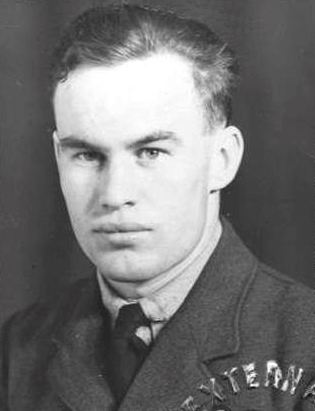
On the inevitable “last” leg running up to the target there wasn’t a cloud in the sky which makes a blind-marker feel rather naked. As we were +22 the German defences had time to set up for us and searchlights were like driving down a city street. But having previously flown through searchlights and flak without “getting it” we had the usual butterflies. However, we got coned (for the first time) whereupon the pilot took evasive action. One shell burst above us and the ONLY hole in the K was the canopy above the pilot, from which a piece of shrapnel entered his lung.
Right: F/O. Harold Allan Hannah
Of course Hannah immediately went unconscious, thus slumped over the control column, and Catlin (standing beside) announced the situation. Martin and I left our navigator bench and the three of us wrestled Hannah out of his chair. That wasn’t very easy in a very confined space with everyone tangled up with inter-com wires, oxygen tubes, etc., and I recall it took at least five minutes. We merely dumped the pilot on the floor (for the time being).
Flip-Flopped:
During that time we flip-flopped all over the sky. When one of us saw the nose diving we’d all pull back on the stick etc...I’m sure we almost looped-the loop at times. We lost altitude from 17,000 to about 5,000 ft., still with the bomb doors open and our bombs still aboard. Martin, who was the most senior, immediately took over by climbing into the pilot’s seat.
You must keep in mind that Martin had NEVER flown any a/c, let alone a Lancaster bomber. However, he used to play with a Link trainer on non-flying days, hence knew a little about the dials. Once he got “settled in” we continued SE direction, for an estimated half hour before Martin could get the thing turned around, jettison the bombs etc. As my navigation was long lost due to the above excitement, I gave a course of “North-west to England” (in due time I got reorganised) and with the engineer he (Martin) climbed to about 10,000 ft. For his “first solo” he did quite will except for wiggling 10 degrees off course both ways. He also did some “porpoising” but that was a minor detail at that time. He had considerable “help” from AG Pirie who instructed him in raising (or lowering) the nose, L or R wing etc...
We couldn’t do much for Hannah except for a shot of morphine and some pain pills. He remained unconscious all the way home.
We had several crew conferences on the way home, trying to decide the best thing to do. One of the lectures said that we should get over England, shove the wounded out on a parachute, head the a/c out to North Sea and the rest of the crew bale out. But we were still too chicken for that course of action.
During WW II there was a “crash” drome on the east coast of England - about five miles square and our next decision was to do a belly landing on that. But we couldn’t find that drome which didn’t respond to our wireless pleas.
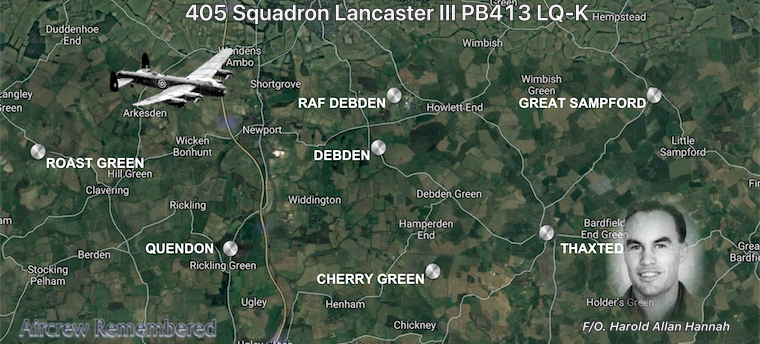 No Answer:
No Answer:
In any case, as I recall, we came to a firm crew decision, so we plodded along to home base at Gransden Lodge, which was in darkness and didn’t answer our call. Not surprising as we were about two hours late thus probably written off in the meantime. Martin had descended K to about 2000 ft.
In response to our “May-Day” call the USAAF base at Debden answered, turning on all lights etc., and the control tower proceeded to talk us down (like you’d see in a movie). Again a rainy day lecture came to mind which reminded us to let all doors fly away and the crew got into crash positions. After the engineer reminded Martin that we only had 20 minutes of petrol left he (Martin) did his “final” turn for a belly landing. You can imagine anyone doing their very first landing! The following conversation will be burned into my brain forever:
Controller: “K King you’re much too high and off the runway.” Martin: (in his English accent) “OK, I’ll go around again”
Whereupon he pulled back on the stick - but the engineer had left for crash position and he neglected to give some throttle. Naturally K went into the most gentle stall and found the only open field (for miles around) about half mile past the base. (During our descent our a/c barely missed the top of a farm house by inches? as we heard later). To help us the ground sloped away hence the tail caught first which was as ideal as possible. To be truthful (40 years later) I thought this was the end and expected all sorts of bits and pieces to be flying around. But nothing! Just calm and quiet! All but some red lights flashing, as no one had shut off any unnecessary switches. Just in case a fire started everyone hustled out of the a/c making sure we got Hannah out.
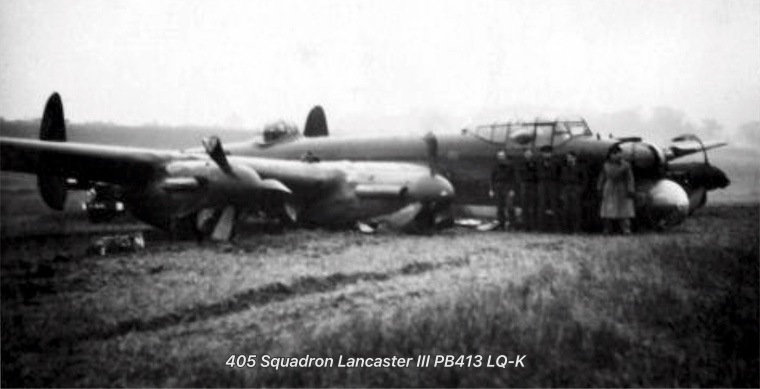
DSO:
Martin was awarded an immediate DSO for what he called his “first, only and last solo”.
While flopping around the sky around Dusseldorf our rear gunner, Tito Perini, baled out, became a PoW and came back to Canada in Jun 45 on the same ship as most of our crew. We called the pilot “Hal” and when trying to get him out of the seat apparently Martin said “Get Hal out of here” which Perini mistook for “Get to hell out of here”. Quite understandable under the circumstances!
I wish this story had a real happy ending after our efforts to bring Hannah home. But after being moved to several hospitals, he died on the 27th Jan 1945 in a Midhurst, Sussex hospital.
Martin, who Cope calls a “real extrovert with a slight fringe of reddish hair thus fitting his nickname Curly”, recalled his memories of that night in an interview for a BBC radio program. The following are excerpts from that broadcast.
The engineer, Ron, up front, said that Harold was hit; the rear gunner, Tito, asked what went on; the mid-upper gunner, Barney, told us that we were diving and turning right. I went forward, breaking inter-com contact, to find that Harold, the pilot, had fallen forward on the controls and was feebly flailing his arms. Ron and I had a try at sitting him up, and heaving back on the control column, but it was soon clear that he was hard hit, and that he had to be got out of the pilot’s seat so that someone could take over the controls. Being off inter-com, I pulled Ron’s helmet away from his head and yelled in his ear - “Get Hal out of here”, meaning his seat, while I tried to lift the starboard wing to stop our turning motion, for I was fearing (among other things) a spin.
This must have been heard by the rear-gunner, Tito, as “Get the hell out of here”, for he baled out and this was the most likely time. No blame to him; our antics felt pretty wild up at the wing; what they must have been like down at the tail only God and a gunner could tell you.
We at last got Hal out on the cockpit floor, and I was in the seat. A pilot sits on his parachute, so it was fortunate that I was about four inches taller than Hal; the lack of a cushion didn’t matter so much, and I hadn’t had time to notice, for I was going “solo” for all our lives. Harold was alive but helpless, so it never occurred to any of us to “abandon ship”.
In the course of a couple of years flying I had scrounged a few hours in the Link Trainer, and seen an artificial horizon working, with the line for the horizon, and little aeroplane climbing and diving and tilting in response to the operation of the controls. When on practice flights, Harold had allowed me an hour or so at the controls, so I had the feel of things.
The mass of dials before me made it impossible to sort out compass, altimeter or airspeed indicator. There seemed to be hundreds of them. I had so little idea of our position in the sky that quite literally I didn’t know which way was “up”. About now I found the artificial horizon, and saw the little plane lying right down in the bottom right hand quadrant of its dial, and I remember thinking “That’s it! The gyros have toppled”, which meant that the only dial I knew even vaguely how to use was useless.
The airspeed needle had been around the 300 mph mark all this time, and as far as I recall, we had about 5000 feet to go when at last we were roughly straight and level and under control...Then I saw the loveliest sight I shall ever see. The little airplane on the artificial horizon was back on the job. Maybe the idea of flying that Lanc had scared me witless, but I could fly that little joker, and turn it left or right, so then I knew we might yet get home...
As we flew away from the enemy, we were not very talkative. Jack Burns, the wireless operator, was tending to Harold, and while we could not find any sign of much bleeding, it was clear he was badly hurt, for he was as strong as they come, and plucky, but he was unable to move much, and was very quiet...Ron was tending the motors, to ensure that I didn’t give them too much of a bending and Jake was really bringing clairvoyance into the art of navigation, to off-set my weird flying. We had all agreed that jumping out was out of the question, because Harold was too hard hit to go out that way. This meant that when we got home, I had to try to put the ship down.
I already had some form on this, for a couple of years before I had been in a plane that had unexpectedly landed itself on a hilltop, killing nobody. I therefore decided that we would go in “wheels up” as this should cut out the risks of bouncing up off the wheels, and stalling at 100 feet, or nosing over, or landing on one wheel and a wingtip, and cartwheeling.
All these things being well within the bounds of possibility and very dangerous indeed, if I could keep the aircraft level up to the time of touchdown on its belly, there was a fair chance of us staying right side up, and able to get out.
Jake’s efforts at last succeeded in bringing us over England, and we found ourselves over the right county, (the one with our station in it), and now the tension really began to build, as we began to let down towards the final gamble.
Now I learned how small an airfield looked when you are trying to land on it.
My approach was not improved by the need I had to keep checking on the little plane in the dial. The flying control officer knew it was an amateur doing the flying, for we had told the world, but he clearly saw it, as we came in, and I can hear his tired voice, (or was it deliberately relaxed to help steady me?), saying “You’re aw-a-y too high K. King, better go around”, in a lazy drawl, as if he was correcting a trainee pilot. He was in the control tower, which I could just as easily hit as miss, so his almost studied casualness was all the more admirable. I certainly met some brave men this night.
Good Advice:
His advice was good. The trouble about taking it was that it involved a climb, a turn, a calculated run back past the field, another turn, and then getting myself up to the point of letting down again. By this time I was getting past connected thought; I pulled up the nose without opening the throttles in an effort to climb, saw the airspeed falling to stalling point, put the nose down again to regain speed, saw the little plane wobble and concentrated on steadying that, pulled the nose up again to try to climb, felt that we must be awfully close to landing...then I couldn’t see, hear, or feel anything. I was out to the world.
I now became aware of someone saying “Stop, you bastard, Stop you bastard”, while I was shoving with my feet on the rudder bar, and hauling back on the control column like someone trying to halt a runaway team of horses. And at last I realized the character talking was me. We were down. It had come off.
The drome we had failed, (by about half a mile), to land at did a swift job of guessing where we had gone, for in a very few minutes their ambulance was across the field. It was very noticeable that even a half tumbler of Scotch (this was an American drome, remember) did no more than make us feel nearly normal.
There is a rather amusing footnote to all this.
When Jake and Viola (Cope) came over for their trip, we went to various stations where we had served, and of course to Debden to see the very spot where it all happened. To make it all proper we went to see the farmer whose land we had deep ploughed, to get the OK to take a photo on the spot. The farmhouse is dead in line with Debden’s runway, and I think we might have missed the roof top by about a foot. We were left in no doubt about the farmer’s feelings. Even after 15 years there was an absence of warmth!
This outcome was not a miracle when all the factors are taken into account. Lady Luck did play a critical role in the final outcome: She ensured that an overwhelmed and exhausted Fl/Lt. Martin lost control of PB413 with a low speed, ground level stall onto the downslope of a hill, and fuel tanks down to vapours. However, the events leading up to this remarkable crash landing were almost orchestrated. Perhaps most important was the leadership and skill that their Skipper had demonstrated during their thirty op tour. He had moulded them into a close knit team that could cope with any emergency short of a direct flak hit or devastating night fighter attack. He even prepared them for his own sudden incapacitation. His extensive experience as a flying instructor was a major factor. It is obvious that the brief patter and dual time he spent with his wireless operator were life saving for five of the crew. Fl/Lt. Martin was a veritable sponge! He immediately assumed control and utilized the crew's talents and cooperation to regain control of their gyrating Lanc, release the bomb load, close the bomb bay doors, navigate back home to England and pull off a text book crash landing in the dark onto an unlit field. Not to mention that his decision to land "wheels up" was quite likely life saving. It is most significant that during this adventure their decisions were always focused on ensuring the well being of their admired Skipper, F/O. Harold Hannah.
(1) The family of F/O. Harold Hannah also lost his older brother, F/O. Lloyd Hannah - just weeks earlier. Killed on the 14th October 1944 flying 625 Squadron Lancaster I LL956 CF-Q.
DSO Award Fl/Lt. George Albert Martin L/G 22nd December 1944:
"This officer was air bomber in an aircraft detailed to attack Dusseldorf one night in November, 1944; When nearing the target, the aircraft was hit by shrapnel and the pilot was seriously wounded. With the assistance of another member of his crew, Flight Lieutenant Martin removed his stricken comrade from the pilot's seat and afterwards took over the controls. Flight Lieutenant Martin regained altitude and went on to release the bombs over the target area. He afterwards flew the damaged aircraft to this country and effected a successful crash-landing at the nearest available airfield. This officer displayed the highest standard of courage and determination and, though not so experienced as the regular pilot, was undoubtedly responsible for the safe return of the aircraft and its crew".
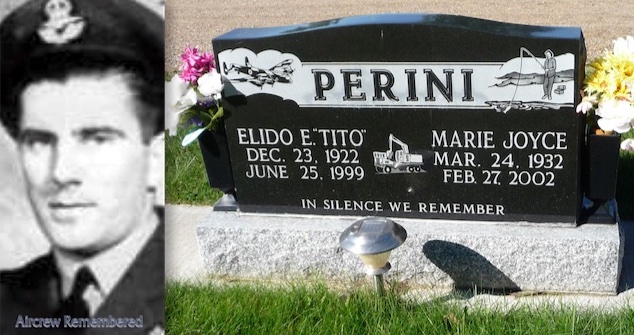
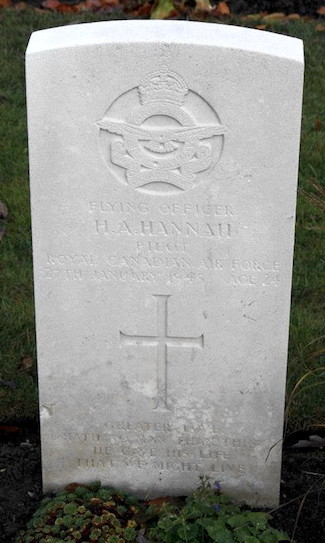
Burial details:
F/O. Harold Allan Hannah. Stonefall Cemetery. Sec. G. Row F. Grave 12. Son of Allan and Mary Hannah, of Moose Jaw, Saskatchewan, Canada. Grave inscription reads: "Greater Love Hath No Man Than This: He Gave His Life That We Might Live". (These words are identical to his older brother's)
Researched and dedicated to the relatives of this crew with thanks to David Langner, Nic Lewis, Joe Williams, Jack Albrecht.
Decoration suggestions by Jack Albrecht: F/O. H.A. Hannah - CGM, eye witness accounts. Fl/Lt. G.A. Martin - CGM, eye witness accounts. F/O. J.L. Cope - CGM, eye witness accounts. Fl/Sgt. J.C. Burns - CGM, eye witness accounts. Sgt. R.C. Catlin - CGM, eye witness accounts. Fl/Sgt. A.I. Pirie - CGM, eye witness accounts. Fl/Sgt. E.E. Perini - DFM, eye witness accounts.
It is note worthy that under similar circumstances that Air Commodore Arthur Harris reversed the recommendation to award two VCs, three CGMs and one DSO, and in their places awarded five of the crew the CGM and one DSO, the only "crew" in the Second World War so decorated.
The submitters are deeply indebted to David Langner for bringing to their attention these remarkable accounts of his two uncles, F/O.'s Lloyd and Harold Hannah. His pride is well founded. It is also quite understandable why the family was disappointed that these two young men were not decorated for their service and sacrifice. It is particularly interesting that the government of France recognised the courage of F/O. Harold Hannah by awarding him the Legion of Honour (1947), yet he was overlooked by England and his home country with the exception of his Operational Wings and Canadian Memorial Cross.